This article has been
cited by other articles in ScienceCentral.
Abstract
In addition to the inherent difficulties of ear reconstruction, including its three-dimensional, symmetrical, and bilateral nature, posttraumatic ear reconstruction is even more challenging because of the destruction of the adjacent soft tissues and vessels following trauma. In severe cases, ipsilateral reconstruction becomes especially difficult. In the case herein, we present posttraumatic single-stage ear reconstruction with a contralateral temporoparietal fascial free flap using a branch of a facial artery as the recipient vessel. Posttraumatic ear reconstruction should be performed after considering the extent of tissue damage, the available treatment options, and the patient’s preferences. In challenging posttraumatic ear reconstruction cases that involve a lack of soft tissue and vessels on the ipsilateral side, a contralateral temporoparietal fascial free flap using a facial artery as the recipient vessel should be considered as a treatment option.
Go to :

Keywords: Acquired ear deformities, Free tissue flaps, Free tissue flaps, Reconstructive surgical procedures
Introduction
The external ear structurally protrudes outward, which makes itself prone to trauma such as traffic accidents, burns, bites, cuts, and other trauma. Due to the unique structure and intricate cartilage folds of the ear, posttraumatic ear deformity can be noticeable and contribute to psychological distress, regardless of the size and extent of the deformity [
1]. Considering the three-dimensional, symmetrical, bilateral nature of the ear, reconstruction can be quite challenging. Moreover, the lack of adjacent soft tissue and the scarring makes posttraumatic ear reconstruction more complicated and challenging than congenital ear reconstruction [
2]. The primary goal of managing ear trauma is to minimize damage and prevent complications such as infection [
3].
In patients whose cartilage is nonsuitable for ear framework, an alloplastic polyethylene implant is a viable alternative [
4]. Frodel and Lee [
5] used Medpor implants for facial deformities after trauma and show low rates of infection.
In order to prepare for posttraumatic ear reconstruction, it is important to assess the location, size, and depth of the defect, and accordingly determine the optimal surgical method [
2]. The treatment options are a local skin flap such as an ipsilateral temporoparietal fascia flap, a mastoid flap, or an expanded skin flap from the mastoid or postauricular areas. However, ipsilateral local flap reconstruction becomes more challenging and unreliable in cases of severe ear trauma. Free flap reconstruction is also challenging if there is superficial temporal artery injury, since it is usually used as the recipient vessel. In this case, we introduce a procedure for single-stage posttraumatic ear reconstruction with a contralateral temporoparietal fascial free flap and a polyethylene auricular implant, using a facial artery branch as the recipient vessel.
Go to :

Case report
The study was approved by the Institutional Review Board of Severance Hospital (No. 2022-3393-001) and performed in accordance with the principles of the Declaration of Helsinki. The patient provided written informed consent for the publication and the use of the clinical images.
A 22-year-old male patient suffered a depressed skull fracture in the right parietal area, a degloving injury on the bilateral frontotemporal area, and amputation of the left external ear after a traffic accident. The patient primarily underwent an anterolateral thigh free flap to cover the left frontotemporal scalp area at another institution. Five months after the accident, the patient visited our institution for external ear reconstruction. Nine months after trauma, single-stage ear reconstruction using a contralateral temporoparietal fascial free flap over a polyethylene ear prosthesis was planned (
Fig. 1).
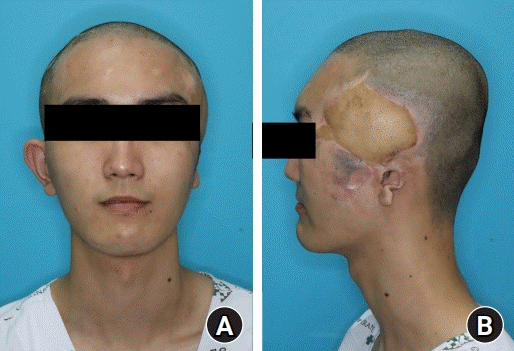 | Fig. 1.Patient’s photograph before operation. Previously operated anterolateral thigh flap and the posttraumatic scar was noted at the frontotemporal area. (A) Front view. (B) Lateral view. 
|
The initial medical report following the accident did not detail the damage depth and extent, making it difficult to determine the viability of the ipsilateral temporoparietal fascia. In addition, the recipient vessel of the previous anterolateral thigh free flap reconstruction was not described, which was on the ipsilateral side of the ear amputation. Moreover, when considering local flap coverage, the surrounding was composed mostly of scar tissue, and the posterior auricular area was too narrow for an expander insertion.
Intraoperatively, dissection was performed to detect the superficial temporal artery. Because the superficial temporal artery was not reliable due to the previous operation, a facial artery and vein were dissected for the recipient vessels. The contralateral temporoparietal fascia was elevated with the superficial temporal artery and vein as pedicle vessels. The flap was 10×5 cm in size, with a pedicle length of 2 cm (
Fig. 2). Subcutaneous tunnel was made beneath the remnant ear lobule. The pedicle was laid caudal to the external auditory meatus via the subcutaneous tunnel. End-to-end microanastomosis was performed with monofilament polyamide #10-0. A ready-made polyethylene framework was selected considering contralateral ear size. The helical rim frame and ear base extended frame were fixed with monofilament polypropylene #4-0 sutures. The fascial flap covered a polyethylene prosthesis framework and was covered with a split-thickness skin graft from the contralateral scalp (
Fig. 3). After the surgery, the flap survived well without any complication (
Figs. 4,
5). The patient is now on regular outpatient visits.
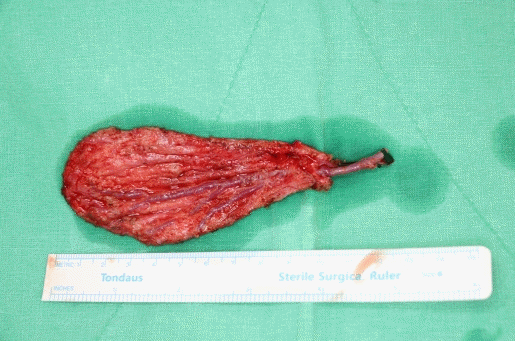 | Fig. 2.Elevated temporoparietal fascia flap with superficial temporal artery. 
|
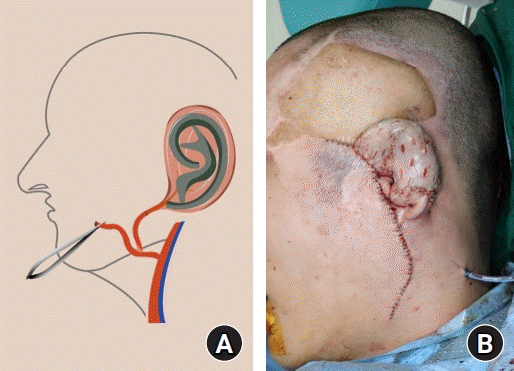 | Fig. 3.(A) Polyethylene ear framework was covered with the fascia flap and laid on desired position. Pedicle was laid caudal to the external auditory meatus, through the subcutaneous tunnel beneath the remnant ear lobule. Microanastomosis was performed between the free flap perforator and facial artery. (B) Immediate postoperative photograph (lateral view). 
|
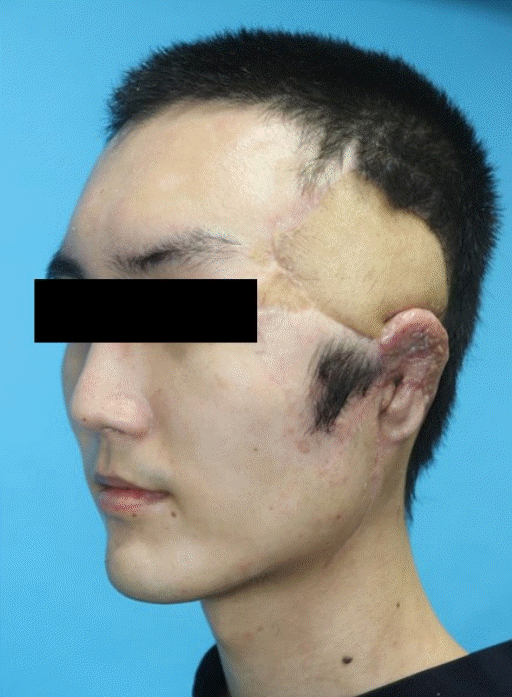 | Fig. 4.A photograph of patient 1 month after the operation. The flap was well-taken without complication. 
|
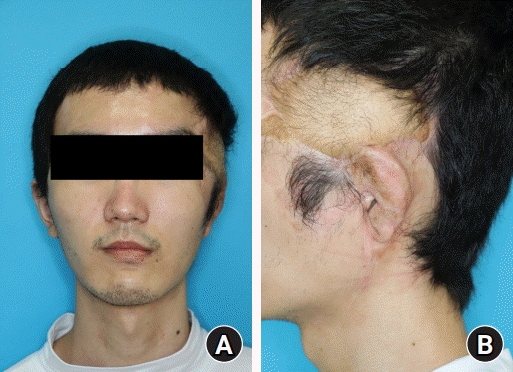 | Fig. 5.A photograph of patient 9 months after the operation. (A) Front view. (B) Lateral view. 
|
Go to :

Discussion
Ear reconstruction is a big challenge in plastic surgery and has a steep learning curve [
3]. Efforts have been made to develop various reconstructive methods from Tanzer [
6] to developments that are still underway. Ear reconstruction can be largely divided into two stages, creating a framework, and then covering the framework using a thin but firm structure [
7]. Posttraumatic ear deformities are usually accompanied by defects of the surrounding structure, so it is especially important to accurately identify the location, size, and depth of the injury to determine the optimal treatment option.
Luo et al. [
2] classified posttraumatic ear deformity into five types, according to the involved tissue components, size of defects, and status of surrounding soft tissues. The most severe type obviously includes partial or total ear loss, with no healthy surrounding skin or soft tissue, including temporoparietal fascia. In the most severe types, it is possible to employ auricular silicone prosthesis with bone anchoring for patients who desire minimal surgical intervention; otherwise, reconstruction with a free flap is possible.
For the free flap reconstruction, temporoparietal fascia free flap and radial forearm free flap are possible options. Temporoparietal fascia is considered as an attractive option in that the fascia is thin and flexible, and scarring can be hidden by the patient’s hair [
8,
9].
An artificial framework or autologous rib cartilage are two options for ear cartilage framework. Autologous rib cartilage is a possible option not only for congenital ear reconstruction but also for posttraumatic ear reconstruction. As the patient gets older, it becomes difficult to make the natural intricate cartilage folds with autologous rib cartilage due to calcification [
10].
For successful reconstruction results, posttraumatic ear reconstruction requires an appropriate choice of surgical method considering the damage. Furthermore, the patient’s preference between single-stage and multiple-stage reconstruction is an important consideration [
2]. In case of two-stage reconstruction, a framework is made with remaining all available structures in the first stage, and auricular elevation is performed in the second stage. In this case, the patient wanted a single-stage ear reconstruction after the trauma of the highest degree combined with an unreliable ipsilateral superficial temporal artery from a previous free flap operation. Single-stage reconstruction with a contralateral temporoparietal fascia free flap using a facial artery as the recipient vessel can be a treatment of choice in similar cases of posttraumatic ear deformity.
Go to :






 PDF
PDF Citation
Citation Print
Print







 XML Download
XML Download